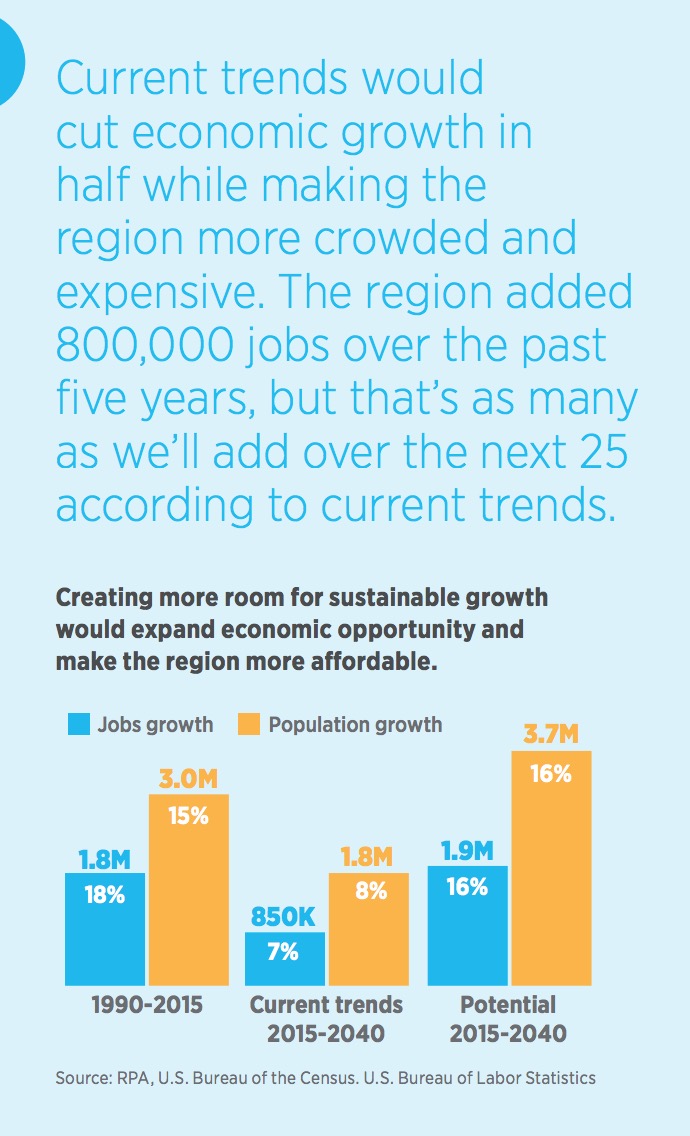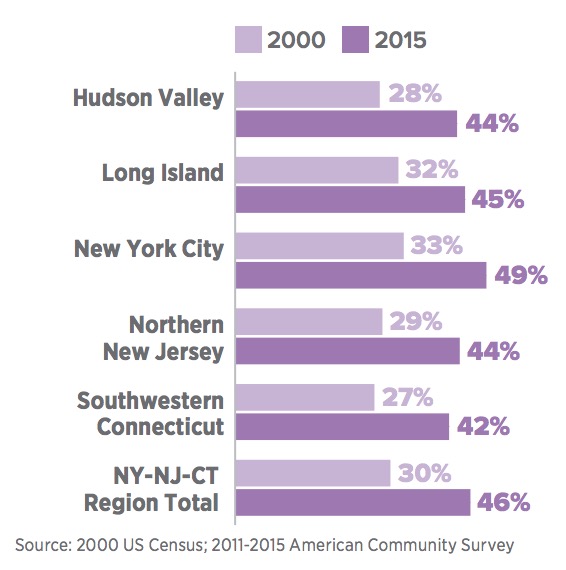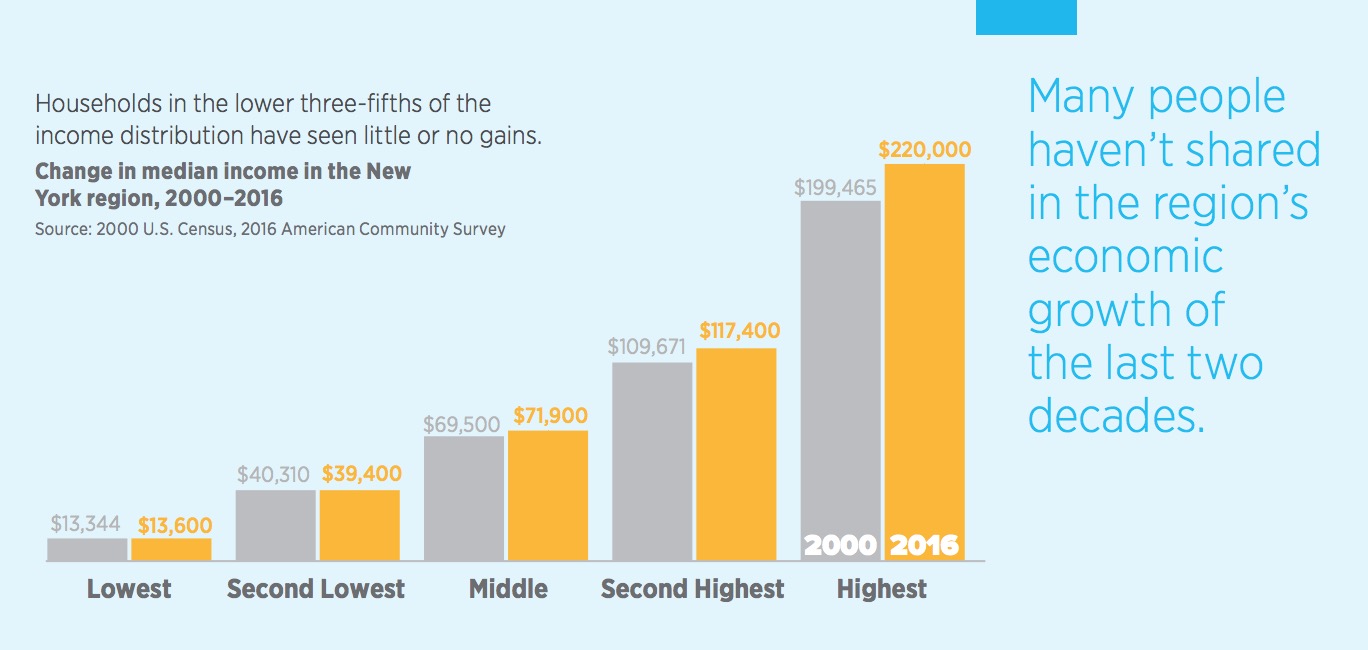REGIONAL PLAN ASSOCIATION (RPA)
The Fourth Regional Plan for the New York-New Jersey-Connecticut Metropolitan Area
If the Regional Plan of New York and Its Environs, from 1922, was about realizing that New York City was part of a larger regional economy and natural ecosystem; if the Second Regional Plan of 1968 was about trying to concentrate unconstrained sprawl into a constellation of regional cities; and if the Third Regional Plan of 1996 was about reinvesting in the infrastructure systems of the region to reassert our prominence on the national and international stage—then the lesson we learned from four years of data analysis and public engagement is that the Fourth Regional Plan is about creating and recreating our public institutions, and shaping them to make positive change happen.
Executive Summary
The Way Forward
 Our work on the Fourth Regional Plan began by talking with and listening to people from across the region. What we heard was that people loved living here, but also had some serious concerns. Housing was too expensive. Commutes were long and unreliable. The destruction brought by Hurricane Irene and Superstorm Sandy underscored our region’s vulnerability to climate change, and raised questions about how prepared we were for the storms to come.
Our work on the Fourth Regional Plan began by talking with and listening to people from across the region. What we heard was that people loved living here, but also had some serious concerns. Housing was too expensive. Commutes were long and unreliable. The destruction brought by Hurricane Irene and Superstorm Sandy underscored our region’s vulnerability to climate change, and raised questions about how prepared we were for the storms to come.
But the most distressing thing we heard was that many people believed these and other problems were just too big to solve.
We have spent the past five years engaged in more discussions and countless hours of research and analysis to better understand these challenges, and to find solutions.
We learned that despite the flourishing economy, future growth is far from guaranteed. The region gained 1.8 million jobs over the past 25 years, but is likely to grow by only half that number over next quarter century. And the growth we’ve experienced has failed to lift the standard of living for far too many households.
Yet if we change course—if we can provide the housing, commercial space, and infrastructure that is needed for all those who want to live here—the region could gain nearly two million additional jobs by 2040. More importantly, this growth could take place in a way that broadly shares prosperity and well-being, overcomes long-standing inequities, promotes a sustainable environment, and prepares the region for climate change.
Achieving this long-range vision of inclusive growth will require rethinking the institutions that govern the region and oversee its infrastructure.
The Fourth Regional Plan includes 61 specific recommendations to achieve greater equity, shared prosperity, better health, and sustainability. It also represents an important opportunity to continue—and intensify—a civic dialogue that breaks through the short-term thinking of the past.
The current crisis
The region’s economy is thriving. After the deep recession of the late 1980s and early 1990s, and the financial crisis of 2008–2009, the tri-state area bounced back. People are choosing to live, work, and visit here. New York City is now one of the safest big cities in the nation. Public health has improved, as has quality of life.
National and global trends towards urbanization have played a part in this renaissance, but intentional policy choices, such as major investment programs in both housing and transit in the 1980s and 1990s, also positioned New York to capitalize on these trends.
But this recent economic success is not guaranteed, and past development trends teach us that growth alone does not always benefit everyone.
For the bottom three-fifths of households, incomes have stagnated since 2000. More people live in poverty today than a generation ago. Those in the middle have fewer good job opportunities and chances to climb the economic ladder. There is greater income inequality in the region than elsewhere in the country.
While household incomes have plateaued, housing costs have risen sharply and are taking a larger share of household budgets. For many people, discretionary income cannot cover critical expenses such as health care, college, child care, and food.
When it becomes too expensive to live here, talented people pick up and leave for more affordable places. It’s no coincidence that peak real estate prices in the mid-2000s coincided with the highest recent level of outward migration.
These dual crises of stagnant wages and rising costs are exacerbated by a legacy of discrimination in housing, transportation, education, and other policies that limit opportunities for low-income residents and people of color. Although the tri-state region is one of the most diverse in the country— nearly half of all residents are people of color, and a third are foreign-born—it is also one of the most segregated.
Growth patterns within the region have changed dramatically over the last generation. Many urban areas have been reinvigorated, but that transition has put new strains on city housing markets and suburban economies.
In the second half of the 20th century, suburbs grew quickly as middle-class and affluent city dwellers were able to take advantage of federal and local policies that promoted suburban home ownership. Cities were left behind, and struggled with growing unemployment, poverty, and crime. Over the last two decades, that trend has reversed, as people and jobs returned to New York and well-positioned cities such as Jersey City, White Plains, and Stamford.
For many towns, villages, and rural communities, this reversal has resulted in fewer local jobs, an aging population, and a smaller tax base. And many older, industrial cities are still struggling to grow their economies.
But for New York and other growing cities, the return of jobs and people has presented new challenges: rising real estate prices and rents, families displaced by unaffordable housing, and neighborhoods that longtime residents no longer recognize as their own. This growth has also put additional pressure on the region’s aging infrastructure, including subways and roads.
The failure to invest in improvements and build new infrastructure has led to disruptions and unreliable services, which are further strained by the impact of severe storms, heat waves, and catastrophic events like Superstorm Sandy and Hurricane Irene. Lives are senselessly lost, and the economic toll registers in the billions of dollars.
 Metropolitan regions around the world are taking on these problems by investing in neighborhoods and business districts; building modern infrastructure that increases capacity, improves resilience, and boosts economic competitiveness; and adopting innovative solutions to protect coastal areas.
Metropolitan regions around the world are taking on these problems by investing in neighborhoods and business districts; building modern infrastructure that increases capacity, improves resilience, and boosts economic competitiveness; and adopting innovative solutions to protect coastal areas.
Yet in our region, government institutions fail to make the difficult decisions necessary to address the persistent problems of affordability, opportunity, and resilience.
Throughout the region, households are spending a much larger share of their income on rents, mortgage payments, and other housing costs. Households spending more than 30 percent of their income on housing, 2000 and 2015
We haven’t amended land-use and building regulations to facilitate the construction of more homes and encourage the development of communities that accommodate families of different incomes. We haven’t sufficiently reformed planning, management, or labor practices to reduce the high costs and slow pace of building new infrastructure. We haven’t modified tax structures to be more fair and promote a more productive and diversified economy. We haven’t built new public transportation to make sure people arrive at their jobs and schools faster. We haven’t done enough to update our technology infrastructure and reduce the digital divide. And we haven’t invested in the physical and natural systems that make our society and economy more resilient when disaster strikes.
View the full plan at FourthPlan.org
About the Regional Plan Association (RPA)
www.rpa.org
RPA is America’s most distinguished urban research and advocacy organization. RPA works to improve the prosperity, infrastructure, sustainability and quality of life of the New York-New Jersey-Connecticut metropolitan region. Some of the region’s most significant public works, economic development and open space projects have their roots in RPA ideas and initiatives, from the location of the George Washington Bridge to the revitalization of downtown Brooklyn, Stamford and Newark to the preservation of open space and development of parks in the Palisades, Governors Island and Gateway National Recreation Area.
Tags: 4th Regional Plan, Connecticut, CT, New Jersey, New York, New York City, NJ, NYC, Regional Plan Association, RPA







 RSS Feed
RSS Feed